這次帶給大家CSS與Sass開發規範,使用CSS與Sass開發規範的注意事項有哪些,以下就是實戰案例,一起來看一下。
ID and class naming
ID和class(類別)名稱總是使用可以反應元素目的和用途的名稱,或其他通用名稱。代替表象和晦澀難懂的名稱。
應該首選具體和反映元素目的的名稱,因為這些是最可以理解的,而且變化的可能性最小。
通用名稱只是多個元素的備用名,他們兄弟元素之間是一樣的,沒有特別意義。
區分他們,使他們具有特殊意義,通常需要為「幫手」。
儘管class(類別)名稱和ID 的語意化對於電腦解析來說沒有什麼實際的意義,
語意化的名稱通常是正確的選擇,因為它們所代表的資訊意義,不包含表現的限制。
不建議
.fw-800 {
font-weight: 800;
}
.red {
color: red;
}
推薦
.heavy {
font-weight: 800;
}
.important {
color: red;
}
合理的避免使用ID
一般情況下ID不應該被套用到樣式。
ID的樣式不能被重複使用並且每個頁面中你只能使用一次ID。
使用ID唯一有效的是確定網頁或整個網站中的位置。
儘管如此,你應該始終考慮使用class,而不是id,除非只使用一次。
不推薦
#content .title {
font-size: 2em;
}
推薦
.content .title {
font-size: 2em;
}
另一個反對使用ID的觀點是含有ID選擇器權重很高。
一個只包含一個ID選擇器權重高於包含1000個class(類別)名稱的選擇器,這使得它很奇怪。
// 这个选择器权重高于下面的选择器
#content .title {
color: red;
}
// than this selector!
html body p.content.news-content .title.content-title.important {
color: blue;
}
CSS選擇器中避免標籤名稱
當建置選擇器時應該使用清晰, 準確且有語意的class(類別)名稱。不要使用標籤選擇器。 如果你只關心你的class(類別)名稱
,而不是你的程式碼元素,這樣會比較容易維護。
從分離的角度考慮,在表現層中不應該分配html標記/語義。
它可能是一個有序列表需要被改成一個無序列表,或者一個p將被轉換成article。
如果你只使用具有實際意義的class(類別)名,
並且不使用元素選擇器,那麼你只需要改變你的html標記,而不用改變你的CSS。
不推薦
p.content > header.content-header > h2.title {
font-size: 2em;
}
推薦
.content > .content-header > .title {
font-size: 2em;
}
盡可能的精確
很多前端開發人員寫選擇器鏈的時候不使用直接子選擇器(註:直接子選擇器和後代選擇器的區別)。
有時,這可能會導致疼痛的設計問題並且有時可能會很耗性能。
然而,在任何情況下,這是一個非常不好的做法。
如果你不寫很通用的,需要匹配到DOM末端的選擇器, 你應該總是考慮直接子選擇器。
考慮下面的DOM:
<article> <span>News event</span> <p> </p> <p> Check this out </p> <p>This is a news article content</p> <p> </p> <p>Buy this</p> <p>Yey!</p> </article>
下面的CSS將會套用到有title類別的全部三個元素。
然後,要解決content類別下的title類別 和 teaser類別下的title類別下不同的樣式,這將需要更精確的選擇器再次重寫他們的樣式。
不推薦
.content .title {
font-size: 2rem;
}
推薦
.content > .title {
font-size: 2rem;
}
.content > .content-body > .title {
font-size: 1.5rem;
}
.content > .content-body > .teaser > .title {
font-size: 1.2rem;
}
縮寫屬性
CSS提供了各種縮寫屬性(如font 字體)應該盡可能使用,即使在只設定一個值的情況。
使用縮寫屬性對於程式碼效率和可讀性是有很有用的。
不推薦
css 代碼:
border-top-style: none; font-family: palatino, georgia, serif; font-size: 100%; line-height: 1.6; padding-bottom: 2em; padding-left: 1em; padding-right: 1em; padding-top: 0;
推薦
css 代碼:
border-top: 0; font: 100%/1.6 palatino, georgia, serif; padding: 0 1em 2em;
0 和單位
省略「0 ”值後面的單位。不要在0值後面使用單位,除非有值。
不推薦
css 代碼:
padding-bottom: 0px; margin: 0em;
推薦
css 代碼:
padding-bottom: 0; margin: 0;
十六進位表示法
#在可能的情況下,使用3個字元的十六進位表示法。
顏色值允許這樣表示,
3個字元的十六進位表示法更簡短。
總是使用小寫的十六進位數字。
不推薦
color: #FF33AA;
推薦
color: #f3a;
ID 和 Class(类) 名的分隔符
使用连字符(中划线)分隔ID和Class(类)名中的单词。为了增强课理解性,在选择器中不要使用除了连字符(中划线)以为的任何字符(包括没有)来连接单词和缩写。
另外,作为该标准,预设属性选择器能识别连字符(中划线)作为单词[attribute|=value]的分隔符,
所以最好的坚持使用连字符作为分隔符。
不推荐
.demoimage {}
.error_status {}
推荐
#video-id {}
.ads-sample {}
Hacks
避免用户代理检测以及CSS“hacks” – 首先尝试不同的方法。通过用户代理检测或特殊的CSS滤镜,变通的方法和 hacks 很容易解决样式差异。为了达到并保持一个有效的和可管理的代码库,这两种方法都应该被认为是最后的手段。换句话说,从长远来看,用户代理检测和hacks
会伤害项目,作为项目往往应该采取阻力最小的途径。也就是说,轻易允许使用用户代理检测和hacks 以后将过于频繁。
声明顺序
这是一个选择器内书写CSS属性顺序的大致轮廓。这是为了保证更好的可读性和可扫描重要。
作为最佳实践,我们应该遵循以下顺序(应该按照下表的顺序):
结构性属性:
display
position, left, top, right etc.
overflow, float, clear etc.
margin, padding
表现性属性:
background, border etc.
font, text
不推荐
.box {
font-family: 'Arial', sans-serif;
border: 3px solid #ddd;
left: 30%;
position: absolute;
text-transform: uppercase;
background-color: #eee;
right: 30%;
isplay: block;
font-size: 1.5rem;
overflow: hidden;
padding: 1em;
margin: 1em;
}
推荐
.box {
display: block;
position: absolute;
left: 30%;
right: 30%;
overflow: hidden;
margin: 1em;
padding: 1em;
background-color: #eee;
border: 3px solid #ddd;
font-family: 'Arial', sans-serif;
font-size: 1.5rem;
text-transform: uppercase;
}
声明结束
为了保证一致性和可扩展性,每个声明应该用分号结束,每个声明换行。
不推荐
css 代码:
.test {
display: block; height: 100px
}
推荐
css 代码:
.test {
display: block;
height: 100px;
}
属性名结束
属性名的冒号后使用一个空格。出于一致性的原因,
属性和值(但属性和冒号之间没有空格)的之间始终使用一个空格。
不推荐
css 代码:
h3 {
font-weight:bold;
}
推荐
css 代码:
h3 {
font-weight: bold;
}
选择器和声明分离
每个选择器和属性声明总是使用新的一行。
不推荐
css 代码:
a:focus, a:active {
position: relative; top: 1px;
}
推荐
css 代码:
h1,
h2,
h3 {
font-weight: normal;
line-height: 1.2;
}
规则分隔
规则之间始终有一个空行(双换行符)分隔。
推荐
css 代码:
html {
background: #fff;
}
body {
margin: auto;
width: 50%;
}
CSS引号
属性选择器或属性值用双引号(””),而不是单引号(”)括起来。
URI值(url())不要使用引号。
不推荐
css 代码:
@import url('//cdn.com/foundation.css');
html {
font-family: 'open sans', arial, sans-serif;
}
body:after {
content: 'pause';
}
推荐
css 代码:
@import url(//cdn.com/foundation.css);
html {
font-family: "open sans", arial, sans-serif;
}
body:after {
content: "pause";
}
选择器嵌套 (SCSS)
在Sass中你可以嵌套选择器,这可以使代码变得更清洁和可读。嵌套所有的选择器,但尽量避免嵌套没有任何内容的选择器。
如果你需要指定一些子元素的样式属性,而父元素将不什么样式属性,
可以使用常规的CSS选择器链。
这将防止您的脚本看起来过于复杂。
不推荐
css 代码:
// Not a good example by not making use of nesting at all
.content {
display: block;
}
.content > .news-article > .title {
font-size: 1.2em;
}
不推荐
css 代码:
// Using nesting is better but not in all cases
// Avoid nesting when there is no attributes and use selector chains instead
.content {
display: block;
> .news-article {
> .title {
font-size: 1.2em;
}
}
}
推荐
css 代码:
// This example takes the best approach while nesting but use selector chains where possible
.content {
display: block;
> .news-article > .title {
font-size: 1.2em;
}
}
嵌套中引入 空行 (SCSS)
嵌套选择器和CSS属性之间空一行。
不推荐
css 代码:
.content {
display: block;
> .news-article {
background-color: #eee;
> .title {
font-size: 1.2em;
}
> .article-footnote {
font-size: 0.8em;
}
}
}
推荐
css 代码:
.content {
display: block;
> .news-article {
background-color: #eee;
> .title {
font-size: 1.2em;
}
> .article-footnote {
font-size: 0.8em;
}
}
}
上下文媒体查询(SCSS)
在Sass中,当你嵌套你的选择器时也可以使用上下文媒体查询。
在Sass中,你可以在任何给定的嵌套层次中使用媒体查询。
由此生成的CSS将被转换,这样的媒体查询将包裹选择器的形式呈现。
这技术非常方便,
有助于保持媒体查询属于的上下文。
第一种方法这可以让你先写你的手机样式,然后在任何你需要的地方
用上下文媒体查询以提供桌面样式。
不推荐
css 代码:
// This mobile first example looks like plain CSS where the whole structure of SCSS is repeated
// on the bottom in a media query. This is error prone and makes maintenance harder as it's not so easy to relate
// the content in the media query to the content in the upper part (mobile style)
.content-page {
font-size: 1.2rem;
> .main {
background-color: whitesmoke;
> .latest-news {
padding: 1rem;
> .news-article {
padding: 1rem;
> .title {
font-size: 2rem;
}
}
}
> .content {
margin-top: 2rem;
padding: 1rem;
}
}
> .page-footer {
margin-top: 2rem;
font-size: 1rem;
}
}
@media screen and (min-width: 641px) {
.content-page {
font-size: 1rem;
> .main > .latest-news > .news-article > .title {
font-size: 3rem;
}
> .page-footer {
font-size: 0.8rem;
}
}
}
推荐
css 代码:
// This is the same example as above but here we use contextual media queries in order to put the different styles
// for different media into the right context.
.content-page {
font-size: 1.2rem;
@media screen and (min-width: 641px) {
font-size: 1rem;
}
> .main {
background-color: whitesmoke;
> .latest-news {
padding: 1rem;
> .news-article {
padding: 1rem;
> .title {
font-size: 2rem;
@media screen and (min-width: 641px) {
font-size: 3rem;
}
}
}
}
> .content {
margin-top: 2rem;
padding: 1rem;
}
}
> .page-footer {
margin-top: 2rem;
font-size: 1rem;
@media screen and (min-width: 641px) {
font-size: 0.8rem;
}
}
}
嵌套顺序和父级选择器(SCSS)
当使用Sass的嵌套功能的时候,
重要的是有一个明确的嵌套顺序,
以下内容是一个SCSS块应具有的顺序。
当前选择器的样式属性
父级选择器的伪类选择器 (:first-letter, :hover, :active etc)
伪类元素 (:before and :after)
父级选择器的声明样式 (.selected, .active, .enlarged etc.)
用Sass的上下文媒体查询
子选择器作为最后的部分
The following example should illustrate how this ordering will achieve a clear structure while making use of the Sass parent selector.
Recommended
css 代码:
.product-teaser {
// 1. Style attributes
display: inline-block;
padding: 1rem;
background-color: whitesmoke;
color: grey;
// 2. Pseudo selectors with parent selector
&:hover {
color: black;
}
// 3. Pseudo elements with parent selector
&:before {
content: "";
display: block;
border-top: 1px solid grey;
}
&:after {
content: "";
display: block;
border-top: 1px solid grey;
}
// 4. State classes with parent selector
&.active {
background-color: pink;
color: red;
// 4.2. Pseuso selector in state class selector
&:hover {
color: darkred;
}
}
// 5. Contextual media queries
@media screen and (max-width: 640px) {
display: block;
font-size: 2em;
}
// 6. Sub selectors
> .content > .title {
font-size: 1.2em;
// 6.5. Contextual media queries in sub selector
@media screen and (max-width: 640px) {
letter-spacing: 0.2em;
text-transform: uppercase;
}
}
}
相信看了本文案例你已经掌握了方法,更多精彩请关注php中文网其它相关文章!
推荐阅读:
以上是CSS與Sass開發規範的詳細內容。更多資訊請關注PHP中文網其他相關文章!
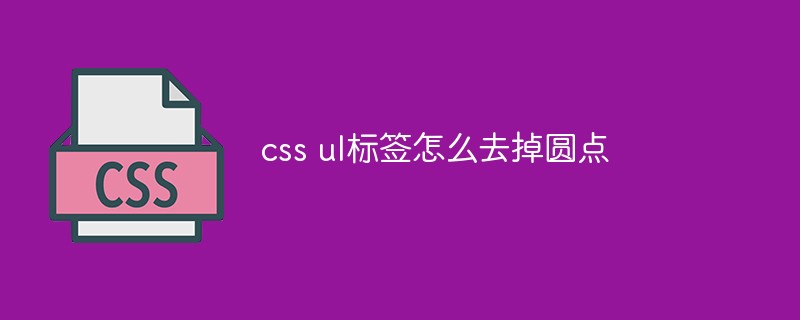 css ul标签怎么去掉圆点Apr 25, 2022 pm 05:55 PM
css ul标签怎么去掉圆点Apr 25, 2022 pm 05:55 PM在css中,可用list-style-type属性来去掉ul的圆点标记,语法为“ul{list-style-type:none}”;list-style-type属性可设置列表项标记的类型,当值为“none”可不定义标记,也可去除已有标记。
 css与xml的区别是什么Apr 24, 2022 am 11:21 AM
css与xml的区别是什么Apr 24, 2022 am 11:21 AM区别是:css是层叠样式表单,是将样式信息与网页内容分离的一种标记语言,主要用来设计网页的样式,还可以对网页各元素进行格式化;xml是可扩展标记语言,是一种数据存储语言,用于使用简单的标记描述数据,将文档分成许多部件并对这些部件加以标识。
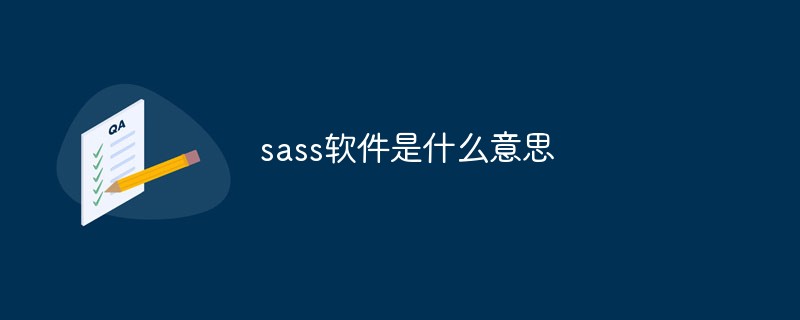 sass软件是什么意思Aug 15, 2022 am 11:39 AM
sass软件是什么意思Aug 15, 2022 am 11:39 AMsass全称“Software as a service”,意思为“软件即服务”;它是一种软件部署模式,第三方供应商在云基础设施上构建应用程序,并以订阅的形式,通过互联网向客户提供这些应用程序,不要求客户预先建设底层基础设施。这意味着软件可以在任何有互联网连接和网络浏览器的设备上访问,而不像传统软件那样只能在本地机器上安装。
 css3怎么实现鼠标隐藏效果Apr 27, 2022 pm 05:20 PM
css3怎么实现鼠标隐藏效果Apr 27, 2022 pm 05:20 PM在css中,可以利用cursor属性实现鼠标隐藏效果,该属性用于定义鼠标指针放在一个元素边界范围内时所用的光标形状,当属性值设置为none时,就可以实现鼠标隐藏效果,语法为“元素{cursor:none}”。
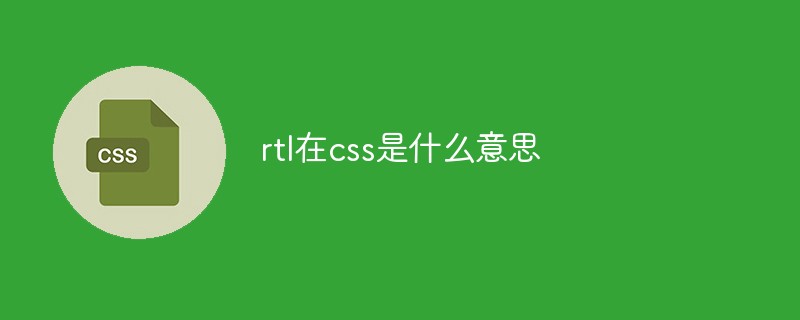 rtl在css是什么意思Apr 24, 2022 am 11:07 AM
rtl在css是什么意思Apr 24, 2022 am 11:07 AM在css中,rtl是“right-to-left”的缩写,是从右往左的意思,指的是内联内容从右往左依次排布,是direction属性的一个属性值;该属性规定了文本的方向和书写方向,语法为“元素{direction:rtl}”。
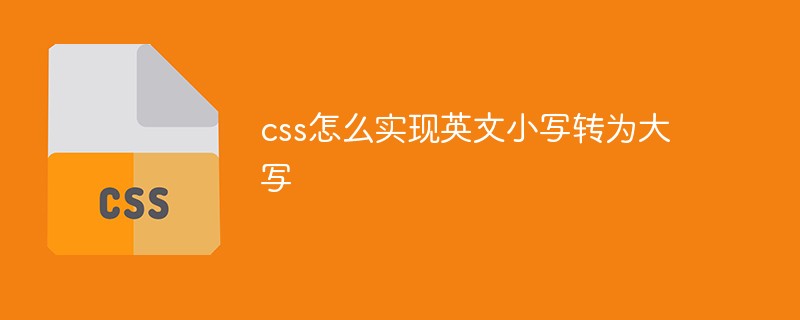 css怎么实现英文小写转为大写Apr 25, 2022 pm 06:35 PM
css怎么实现英文小写转为大写Apr 25, 2022 pm 06:35 PM转换方法:1、给英文元素添加“text-transform: uppercase;”样式,可将所有的英文字母都变成大写;2、给英文元素添加“text-transform:capitalize;”样式,可将英文文本中每个单词的首字母变为大写。
 css怎么设置i不是斜体Apr 20, 2022 am 10:36 AM
css怎么设置i不是斜体Apr 20, 2022 am 10:36 AM在css中,可以利用“font-style”属性设置i元素不是斜体样式,该属性用于指定文本的字体样式,当属性值设置为“normal”时,会显示元素的标准字体样式,语法为“i元素{font-style:normal}”。
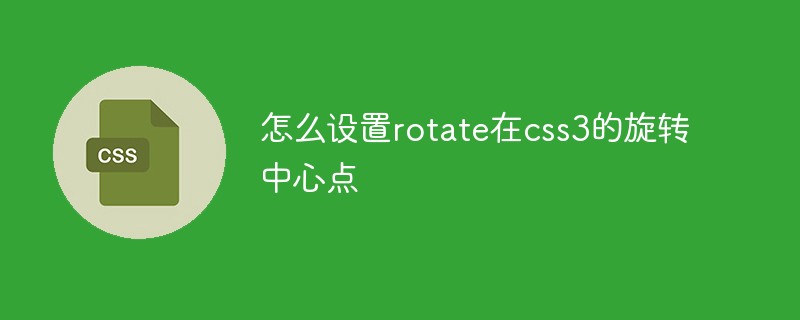 怎么设置rotate在css3的旋转中心点Apr 24, 2022 am 10:50 AM
怎么设置rotate在css3的旋转中心点Apr 24, 2022 am 10:50 AM在css3中,可以用“transform-origin”属性设置rotate的旋转中心点,该属性可更改转换元素的位置,第一个参数设置x轴的旋转位置,第二个参数设置y轴旋转位置,语法为“transform-origin:x轴位置 y轴位置”。


熱AI工具

Undresser.AI Undress
人工智慧驅動的應用程序,用於創建逼真的裸體照片

AI Clothes Remover
用於從照片中去除衣服的線上人工智慧工具。

Undress AI Tool
免費脫衣圖片

Clothoff.io
AI脫衣器

AI Hentai Generator
免費產生 AI 無盡。

熱門文章

熱工具

SublimeText3 Mac版
神級程式碼編輯軟體(SublimeText3)

SAP NetWeaver Server Adapter for Eclipse
將Eclipse與SAP NetWeaver應用伺服器整合。

ZendStudio 13.5.1 Mac
強大的PHP整合開發環境

mPDF
mPDF是一個PHP庫,可以從UTF-8編碼的HTML產生PDF檔案。原作者Ian Back編寫mPDF以從他的網站上「即時」輸出PDF文件,並處理不同的語言。與原始腳本如HTML2FPDF相比,它的速度較慢,並且在使用Unicode字體時產生的檔案較大,但支援CSS樣式等,並進行了大量增強。支援幾乎所有語言,包括RTL(阿拉伯語和希伯來語)和CJK(中日韓)。支援嵌套的區塊級元素(如P、DIV),

SublimeText3 英文版
推薦:為Win版本,支援程式碼提示!





